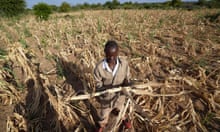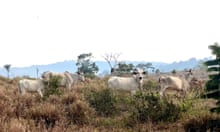Across the UK, farmers are looking at the sky and begging for rain.
Some areas of southern England, where much of the country’s food is grown, have not had any significant rainfall since June. This has put huge pressure on this year’s harvest but things next year could be even worse. The soil in much of the country is too dry to drill, and many crops for harvest later this year and next year need to be drilled by the end of October to be viable.
Livestock are being fed winter stocks of hay now, because the grass has dried up and there is nothing for them to eat – raising fears they will have to be slaughtered early in winter when food runs out.
The amount of water needed for crops this year has also increased due to the lack of rain, so farmers have been emptying reservoirs. Statistics from the UK Centre of Ecology and Hydrology show that in order for rivers and reservoirs to get to normal levels by next year, above average rainfall is needed for months in a row.
Martin Lines, the UK chair of the Nature Friendly Farming Network, grows mostly winter cereals on his Cambridgeshire farm. He said: “We are seeing the impacts of the drought on our spring crops we are harvesting at the moment and a reduced crop yield. Many farmers growing vegetables are running out of water and seeing crops’ potential being lost.
“We should be planting our next oilseed rape crops at the moment but there is no moisture in the soil for them to germinate and grow. With the current crisis in Ukraine this could mean a further reduction in vegetable oil production next year.
“We need the government and supply chains to step up and take our changing climate and drought more seriously. We have under-invested in water management and storage for far too long. We are seeing crops being thrown away because they haven’t made the right size because of the weather. We need all edible crops to reach the table and the supply chains and consumers need to change the demands for perfect-looking products.”
Some farmers have managed to shield themselves – so far – from the worst effects of the dry weather by adopting nature-friendly farming methods.
Healing the soil
Pete Thompson runs Brook Farm in Essex, one of the driest parts of the country. He grows vegetables, mostly brassicas and spring onions. After spending a few years trying to improve the soil structure so it holds moisture better, he says he has just about managed to keep things going.
In recent decades farmers have grown crops in fields, then harvested, then ploughed, then sown, then harvested and ploughed again, meaning that organic matter is stripped from the soil, making it poorer quality. Thompson has been ensuring crop residue remains in the soil, decomposing and improving its quality.

“You can see a noticeable difference in yield in the fields which have organic matter put back into them, which is cover crops and the way we grow our crops, we incorporate quite a lot of crop residue and try to constantly build organic matter,” he said.
“Where that hasn’t happened you’ve seen that the crops haven’t done quite as well. The decomposing plant matter helps the soil structure.”
He is still having problems with drilling next year’s harvest, though. “Now we are having cost and planning issues as we are having to irrigate before we drill as well as after we drill, as the soil is so dry.”
after newsletter promotion
Jake Freestone, a regenerative farmer from Tewkesbury in the Cotswolds, told the Guardian he had found a 10C temperature difference between soil that has cover crops and organic matter and that which does not. He says the methods he uses make soil act as a “massive sponge”, holding water and needing less irrigation.
Growing olives in Essex
Thompson is growing olives on the slopes of his farm, hoping the roots of the tree will help stop soil erosion. They could also, potentially, be a viable crop as the climate heats up. “We have an olive project, a long-term project to identify suitable varieties for the UK. We’ve been picking olives and this year’s crop is looking quite good – they thrive in hot, arid conditions. It looks pretty Mediterranean at the moment. It also works planting trees on slopes where we have had soil erosion problems – they have reduced soil erosion and it helps biodiversity.”
Shelter for sheep
Lots of the farmers the Guardian spoke to have reaped benefits from the hedgerows and trees they have planted. Animals have been facing heat stress in the high temperatures, but farmers who have planted trees for biodiversity have found they have supplied shade for their livestock.
Jo Cartwright, who runs Swillington Organic Farm in Leeds, found her cattle were able to take respite from the heat under trees. “We have plenty of natural shelter from trees which the stock spend a lot of time under in hot weather,” she said. However, “the downside of this is flies”, she added.
Patricia Prabhu, a sheep farmer from Wales, said: “The sheep have been able to shelter from the heat under the overhanging branches of trees and hedgerows I have planted.”
Natural grasses and rewilded areas
While traditional grasses have suffered in the heat due to the thin soil and short stature of the plants, farmers who have diversified their landscapes to include ancient meadows and grasslands, and have not been overgrazing areas, have found they are managing without supplementary feeding.
Cartwright said: “I reduced stocking rates [the density of animals on the land] last year and although grass is drying up, [have] not had to feed any supplementary fodder yet. Part of the farm is marsh or rough grazing which holds up well in drought conditions.”
Tim Jury, who runs Freshwinds at Pickham Farm in Hastings, uses “mob grazing” to keep his grasses long and of high quality. This method is about emulating nature, so doing what bison and other large ruminants did back when the land was wild. The land is grazed by a high density of animals for a short period, then given a long rest period. This allows the grass to be fertilised by their dung and grow, and results in lots of different heights of vegetation, which is good for biodiversity.
“Mob grazing protected the soil surface and allowed the calves to find cooler temperatures at ground level. Recently planted trees didn’t make it, but we will try again this winter,” he said.










